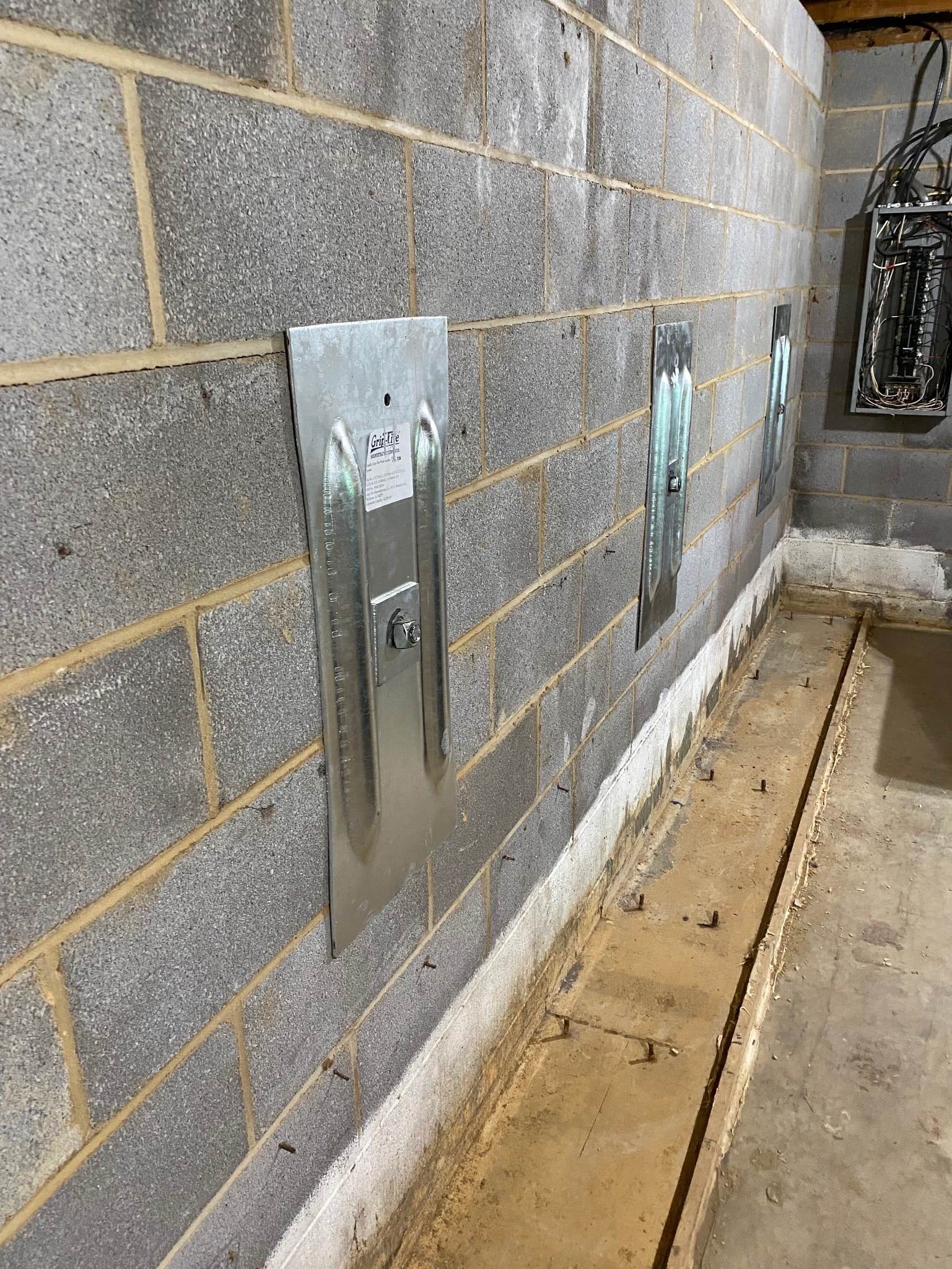
If you’ve walked into your basement and noticed that the walls appear to be curving inward, you’re likely facing more than a cosmetic issue. Bowed basement walls are a serious sign of foundation stress—a warning that the structural integrity of your home could be compromised.
This isn’t a problem you can ignore or patch up with drywall. Bowed walls are often caused by external pressure, such as saturated soil pushing against the foundation. Left untreated, the situation can escalate into cracking, water intrusion, or even wall collapse.
In this article, we’ll explain why basement walls bow, what signs to look for, and the proven professional repair solutions that restore safety and prevent further damage.
Key Takeaways
- Bowed basement walls result from lateral pressure, usually caused by soil expansion or water buildup.
- Horizontal cracks, wall movement, and moisture are common warning signs.
- Untreated bowed walls can lead to water leaks, mold growth, and structural failure.
- Proven repair methods include wall anchors, carbon fiber reinforcement, and helical tiebacks.
- Timely, professional intervention can stop further damage and restore your home’s stability.
Understanding Bowed Basement Walls
Basement walls are designed to resist the natural pressure exerted by the surrounding soil. However, when that pressure increases beyond what the wall was built to withstand, the wall can begin to bend inward. This phenomenon is what’s known as wall bowing.
While minor bowing may seem harmless at first, it’s often a progressive issue. Over time, the bending can increase, cracks may appear, and the risk of collapse becomes very real. Identifying the problem early is key to avoiding major damage and costly repairs.
Causes of Bowed Basement Walls
1. Hydrostatic Pressure
The most common culprit is hydrostatic pressure, which occurs when water builds up in the soil around your foundation. Poor drainage, heavy rain, or a high water table can saturate the soil, increasing its weight and pressure on basement walls.
2. Expansive Soils
Soils rich in clay expand significantly when wet and shrink when dry. This expansion creates lateral pressure that pushes against the wall, causing it to bow inward.
3. Frost Heave
In colder climates, moisture in the soil can freeze and expand. This phenomenon, known as frost heave, also increases lateral pressure and can deform basement walls over time.
4. Improper Backfilling
During construction, if soil is over-compacted or filled too tightly against the foundation, it can exert unintended pressure, especially before the foundation has fully cured.
5. Tree Roots and Landscaping
Large tree roots growing near the foundation can disrupt the soil or exert mechanical pressure against the walls. Additionally, poorly managed landscaping may cause water to pool around the foundation, worsening hydrostatic stress.
Signs and Symptoms of Bowed Walls
The signs of bowed basement walls are often visible and progressive. Early detection is critical.
- Horizontal cracks: Especially near the mid-height of block or concrete walls, indicating pressure from outside.
- Stair-step cracks: Common in brick or block walls, usually paired with signs of movement.
- Bulging or inward-curving walls: Obvious distortion of the wall structure.
- Moisture or water stains: May appear around or through cracks.
- Gaps between walls and floor or ceiling: A sign of displacement or wall shift.
These symptoms usually indicate the wall is no longer structurally sound and may continue to worsen if untreated.
Proven Repair Solutions for Bowed Walls
The most effective repairs for bowed basement walls focus on both stopping further movement and restoring stability. The right solution depends on how far the wall has bowed and the soil conditions surrounding your home.
1. Wall Anchors
Wall anchor systems are ideal for walls that have bowed less than 2 inches. These systems use steel plates inside the basement and large anchors buried in the yard. A steel rod connects the two, and when tightened, the wall is gradually pulled back into place.
Benefits:
- Stops further inward movement
- Can straighten walls over time
- Permanent and cost-effective
2. Carbon Fiber Reinforcement
For minor bowing or to prevent further movement in early stages, carbon fiber straps are bonded vertically to the wall. These high-tensile-strength materials are incredibly thin but stronger than steel.
Benefits:
- Minimal disruption to interior space
- Quick installation
- Prevents further movement (does not straighten)
3. Helical Tiebacks
Helical tiebacks are used for more severe cases of wall bowing. These screw-like steel rods are driven diagonally through the wall into stable soil, then tensioned to pull the wall back into alignment.
Benefits:
- Can correct moderate to severe bowing
- Provides lateral resistance
- Durable and engineer-approved
4. Steel I-Beams
Also known as steel channel bracing, these beams are installed vertically and secured at the floor and ceiling. While they don’t move the wall, they prevent additional bowing.
Benefits:
- Affordable and effective
- Ideal for homes where yard space is limited
Prevention and Maintenance
While environmental conditions can’t be controlled, several steps can reduce the risk of future wall bowing:
- Maintain proper drainage: Ensure gutters are clean and downspouts extend away from the foundation.
- Improve grading: The yard should slope away from the home to divert water.
- Install a sump pump or French drain: This keeps water from building up around basement walls.
- Avoid planting large trees too close: Roots can damage soil balance and structure.
- Schedule annual inspections: Especially after heavy rains or seasonal changes.
Frequently Asked Questions
Is a bowed basement wall dangerous?
Yes. A bowed wall indicates that external pressure is exceeding the wall’s capacity. Left untreated, it can lead to wall collapse or extensive structural damage.
Can a bowed wall be straightened?
In many cases, yes. Wall anchors and helical tiebacks can gradually pull walls back into their original position. The degree of correction depends on the severity and how early the issue is addressed.
How much does it cost to fix a bowed wall?
Costs vary based on the solution:
- Wall anchors: $2,000–$5,000
- Carbon fiber: $500–$1,500 per strap
- Helical tiebacks: $5,000–$10,000
- Steel I-beams: $300–$700 per beam
Always request a professional assessment for accurate pricing.
Is wall bowing covered by insurance?
Most homeowners insurance policies do not cover foundation issues like wall bowing unless caused by a covered peril (like a burst pipe). Check your policy or speak to your provider.
Can I stay in my home during wall repair?
Yes. Most bowed wall repairs—such as carbon fiber or wall anchors—are non-invasive and allow you to remain at home throughout the process.
Conclusion
Bowed basement walls are not just a cosmetic concern—they’re a sign that your home’s foundation is under stress and could be failing. Whether caused by hydrostatic pressure, expansive soils, or poor drainage, bowing should never be ignored.
Fortunately, proven solutions like wall anchors, carbon fiber straps, and helical tiebacks can stop further damage and even restore the wall to its proper position. The key is early intervention and professional expertise.
At Seal-Tite Basement Waterproofing, we’ve spent over 40 years helping homeowners across Virginia, West Virginia, Tennessee, and North Carolina protect their homes with effective, long-lasting foundation repairs. Don’t wait for cracks and curves to turn into costly crises—get your basement walls inspected today.

Seal-tite Basement Waterproofing Co. is a full service basement environment contractor. We carry an A+ Better Business Bureau rating. We repaired over 40,000 homes and structures in Virginia, West Virginia, Tennessee, and North Carolina. We are fully insured and licensed. We have worked in all types of locations, including residential and commercial locations, government agencies, colleges, hospitals, churches, and condo associations.
Seal-tite® offers a lifetime transferable warranty. We carry a Class A Contractor’s License and we are fully insured. Our satisfied customers range from government agencies to businesses, hospitals, colleges, churches, and thousands of homeowners. Your home is probably the single largest investment you will make in your lifetime. Don’t wait, call Seal-tite® to help make your home dry, safe and livable.

